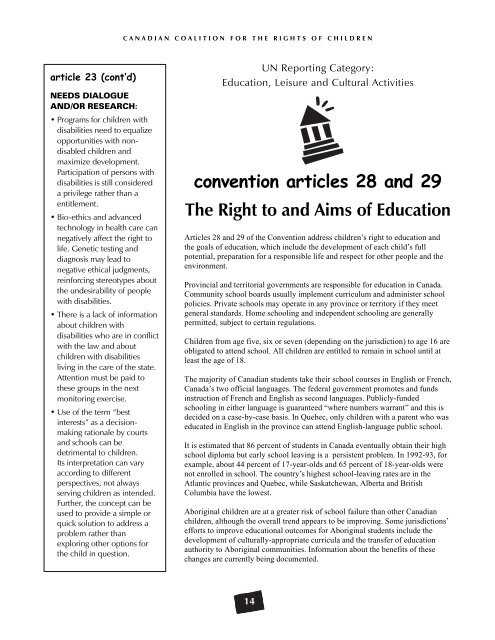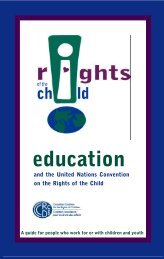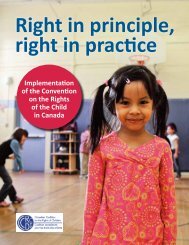Poste - Canadian Coalition for the Rights of Children
Poste - Canadian Coalition for the Rights of Children
Poste - Canadian Coalition for the Rights of Children
Create successful ePaper yourself
Turn your PDF publications into a flip-book with our unique Google optimized e-Paper software.
article 23 (cont’d)<br />
NEEDS DIALOGUE<br />
AND/OR RESEARCH:<br />
• Programs <strong>for</strong> children with<br />
disabilities need to equalize<br />
opportunities with nondisabled<br />
children and<br />
maximize development.<br />
Participation <strong>of</strong> persons with<br />
disabilities is still considered<br />
a privilege ra<strong>the</strong>r than a<br />
entitlement.<br />
• Bio-ethics and advanced<br />
technology in health care can<br />
negatively affect <strong>the</strong> right to<br />
life. Genetic testing and<br />
diagnosis may lead to<br />
negative ethical judgments,<br />
rein<strong>for</strong>cing stereotypes about<br />
<strong>the</strong> undesirability <strong>of</strong> people<br />
with disabilities.<br />
• There is a lack <strong>of</strong> in<strong>for</strong>mation<br />
about children with<br />
disabilities who are in conflict<br />
with <strong>the</strong> law and about<br />
children with disabilities<br />
living in <strong>the</strong> care <strong>of</strong> <strong>the</strong> state.<br />
Attention must be paid to<br />
<strong>the</strong>se groups in <strong>the</strong> next<br />
monitoring exercise.<br />
• Use <strong>of</strong> <strong>the</strong> term “best<br />
interests” as a decisionmaking<br />
rationale by courts<br />
and schools can be<br />
detrimental to children.<br />
Its interpretation can vary<br />
according to different<br />
perspectives, not always<br />
serving children as intended.<br />
Fur<strong>the</strong>r, <strong>the</strong> concept can be<br />
used to provide a simple or<br />
quick solution to address a<br />
problem ra<strong>the</strong>r than<br />
exploring o<strong>the</strong>r options <strong>for</strong><br />
<strong>the</strong> child in question.<br />
C A N A D I A N C O A L I T I O N F O R T H E R I G H T S O F C H I L D R E N<br />
UN Reporting Category:<br />
Education, Leisure and Cultural Activities<br />
convention articles 28 and 29<br />
The Right to and Aims <strong>of</strong> Education<br />
Articles 28 and 29 <strong>of</strong> <strong>the</strong> Convention address children’s right to education and<br />
<strong>the</strong> goals <strong>of</strong> education, which include <strong>the</strong> development <strong>of</strong> each child’s full<br />
potential, preparation <strong>for</strong> a responsible life and respect <strong>for</strong> o<strong>the</strong>r people and <strong>the</strong><br />
environment.<br />
Provincial and territorial governments are responsible <strong>for</strong> education in Canada.<br />
Community school boards usually implement curriculum and administer school<br />
policies. Private schools may operate in any province or territory if <strong>the</strong>y meet<br />
general standards. Home schooling and independent schooling are generally<br />
permitted, subject to certain regulations.<br />
<strong>Children</strong> from age five, six or seven (depending on <strong>the</strong> jurisdiction) to age 16 are<br />
obligated to attend school. All children are entitled to remain in school until at<br />
least <strong>the</strong> age <strong>of</strong> 18.<br />
The majority <strong>of</strong> <strong>Canadian</strong> students take <strong>the</strong>ir school courses in English or French,<br />
Canada’s two <strong>of</strong>ficial languages. The federal government promotes and funds<br />
instruction <strong>of</strong> French and English as second languages. Publicly-funded<br />
schooling in ei<strong>the</strong>r language is guaranteed “where numbers warrant” and this is<br />
decided on a case-by-case basis. In Quebec, only children with a parent who was<br />
educated in English in <strong>the</strong> province can attend English-language public school.<br />
It is estimated that 86 percent <strong>of</strong> students in Canada eventually obtain <strong>the</strong>ir high<br />
school diploma but early school leaving is a persistent problem. In 1992-93, <strong>for</strong><br />
example, about 44 percent <strong>of</strong> 17-year-olds and 65 percent <strong>of</strong> 18-year-olds were<br />
not enrolled in school. The country’s highest school-leaving rates are in <strong>the</strong><br />
Atlantic provinces and Quebec, while Saskatchewan, Alberta and British<br />
Columbia have <strong>the</strong> lowest.<br />
Aboriginal children are at a greater risk <strong>of</strong> school failure than o<strong>the</strong>r <strong>Canadian</strong><br />
children, although <strong>the</strong> overall trend appears to be improving. Some jurisdictions’<br />
ef<strong>for</strong>ts to improve educational outcomes <strong>for</strong> Aboriginal students include <strong>the</strong><br />
development <strong>of</strong> culturally-appropriate curricula and <strong>the</strong> transfer <strong>of</strong> education<br />
authority to Aboriginal communities. In<strong>for</strong>mation about <strong>the</strong> benefits <strong>of</strong> <strong>the</strong>se<br />
changes are currently being documented.<br />
14




